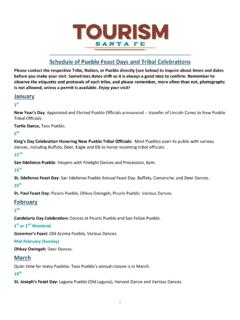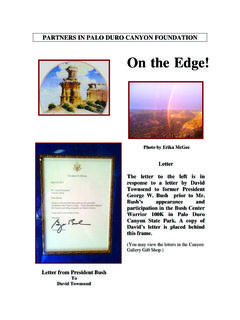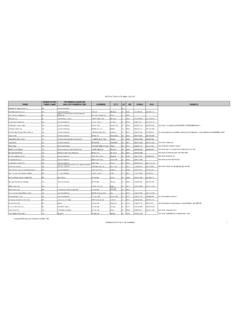Transcription of Jemez Springs, NM
1 Jemez Springs, NMTemperature increase in midwinter matches annual increase has been nearly twice as rapid during midsummer than has declined since 1914 at a rate of per year (simple linear regression).Annual Precipitation (inches)YearAnnual Precipitation (inches)YearFitting 4th order polynomial shows influence of Pacific Decadal Oscillation (PDO)(Note that peaks and troughs are moving lower)Annual Precipitation (inches)YearFitting 4th order polynomial shows influence of Pacific Decadal Oscillation (PDO)(Note that peaks and troughs are moving lower) Jemez River below footbridge(Full scale on y axis)(Y axis scale capped at 250 cfs)Averagemonthly precipitation during 1972 2005 has remained nearly during late 1980s until present has been declining, contributing to Jemez River discharge operations in the Jemez Mountains during the 1960s through the 1980s converted thousands of hectares of old growth forest to dense second-growth the West, whiskey s for drinkin , and water s for fightin over!
2 (Mark Twain)SAHRA Ponderosa pine hydrology siteEC fluxes of carbon, energy, waterSap flow sensors, chemistry, isotopesMeteorological dataSoil water balance, chemistry, isotopesRemote sensing From Tree Bole [m]SWE [cm] From Tree Bole [m]SWE [cm] From Tree Bole [m]SWE [cm] CoverNormalized SWE16 April 2005 ShadingInterceptionSnow Vegetation Interaction: Plot Scale ResultsSouthNorth1. Vegetation shading can delay spring meltMusselman et al. in press2. Vegetation shading may increase snowpack water storage (up to 22%)Snow Vegetation Interaction: Distributed Results II05101520250< 2525 - 50 50 - 75> 75 Canopy Density [%]SWE [cm]Field Survey (900 points) to evaluate the effects of forest density on SWE Snow depths greatest under moderate canopy densities Maximal accumulation under canopy densities between 25% and 45% About 20% more water equivalent under moderate canopy than in open areas Sublimation rates from open snowfields appear similar to those from deep forestConceptual model of Snow Vegetation InteractionsDeep Forestn = 110 Unshaded Openn = 130 Shaded Openn = 65020406080 Valles Caldera Nat.
3 Pres. Ecosystem Services for water production:Thin forests to optimize SWE and reduce winter snowpack loss via sublimationCNP water production = ~20,000 acre-feet/yearo Rancho paid $11,000/acre-foot for Jemez Valley water rights in 006apital value of VCNP water rights = $220 millionLease rate of 10% of capital value per year = $22 million of water roduction annuallyy thinning the second growth forests on VCNP, increase spring noff to Rio Grande Basinnnual stream discharge amount conservatively estimated at 10% crease above current levelsnnual value of ADDITIONAL water = $ million/year!!!ing temperatures er the past 50 years ve led to reduced owpacks and rlier runoffs oughout the untain Runoffk Runoff from Snowmeltrojected globally-averaged sea level rise by the nd of the 21st centuryersSource: IPCC Summary for Policy Makers,February 2007metersSpecies at PikaSpecies at risk from climate changePika habitat is open rocky slopes, with grasses around the edges; snowpack important for thermal cover in heat affects activity periods and thermal-regulatory behaviormate change, with ompanying nges in fire mes and forest cture, will likely e the Jemez ntains salamander ard in elevation, her constricting its ribution and etically isolating populations.
4 Changes in discharge and temperatures in perennial streams will affect fisheriesImplications for restoration efforts of Rio Grande cutthroat troutNon-native brown trout must be removed to ensure RGCT survivalBog birch s southern-most population in Valles Caldera; heavily browsed by elkMODELING WINTER ELK USEEric Wolf, LANLMODEL PROCESSI nitial Cell State = snow in cell + DIi+ standing cropiassess DImax-if snow>21cm, elk excluded from cell (Anderson 1954, Rudd et al. 1983, Fancy and White 1985, Wolf 2001)-if snow<21cm, elk assigned to cell (up to 20) (Mackie 1970, Franklin and Lieb 1979, Shoesmith 1978, Wolf 2001-002)standing crop reduced (Lang 1958, Nelson and Leege 1982, Holecheck et al.)
5 1988)when standing crop reduced to critical threshold (20% of nitial) (Thomas et al. 1988)DI is reduced by 20%-Cell State is reassessed and elk are reassigned to cells atAll Browsing Transect Locations(n = 211)Data from Doug Kranz 2001% of individuals codePercentage of individuals browsed per species over all transects



